TROMSØ ARTIC-ALPINE BOTANICAL GARDEN
NORWAY
Visited June 26rd, 2016
Tromsø city, located on the "arctic island "of Tromsøya, approximately 220 miles inside the Arctic Circle, was our final northerly destination. A late afternoon excursion on Sunday took us to the summit of Storsteinen peak by cable car. From an advantage point of 1,381 feet, we could see the Tromsø Bridge that crosses the strait to connect the mainland east of the island to Tromsøya where we had spent the day in the city center of Tromsø. Snow peaked mountains, higher than our position, lined the numerous fjords where a branch of the Norwegian Atlantic gulf stream current, sweeps up the coast of Norway. Even though Tromsø's latitude corresponds to the same high northern arctic latitude of Greenland, Northern Canada and Northern Siberia, the Atlantic current provides a temperate "sub-arctic" climate year round. This moderation of climate makes Tromsø an ideal location for growing and displaying many Arctic, Antarctic and alpine plants at this worlds farthest northern botanical garden.

Winters are long in Tromsø; late October to early May, including two months of Polar Night where the sun is below the horizon. The heavy snow for six to seven months, does provides natural protection to keep mountain plants dormant and dry. The winter temperatures are considered relatively mild with January, the coldest month, currently listing average temperature of 25.16 degrees F. (-3.8 C.). The summers are short and cool which contribute to larger blossoms and brighter colors than their southern counterparts. With the days of long Arctic light, the growing season is rapid; from late April, with the first blooms of spring gentian and early saxifrages in the botanical garden; Meconopsis blooms in June to the late blooms of Gentiana species that flower in October. July is the warmest month averaging at 53.24 degrees F (11.8C). There is no dry season. Rainfall averages 39.4” (1000mm), per year. The driest month is May when the garden opens. October is the wettest month as the garden prepares for the approaching winter snow. The numbers show that an average of 18.4 days of the month, Tromsø will have rain, sleet or snow. The majority of daylight hours are cloudy or low sun intensity. We were extremely fortunate to have our visit to the garden on a day with glaring sunshine and light jacket weather.

According to Prof. Arve Elvebakk, director of the Botanical Garden of Tromsø at the time of our visit, there are several climate factors that differentiate this far northern botanical garden from southern Scandinavia botanical gardens. The Tromsø Botanical Garden does grows thousands of plant species from all parts of the world. Due to its northern location, the objective of the garden since it opened its doors in 1994, has been to show plants from the polar regions and high mountains. The Meconopsis, Saxifrages, Primula, Micranthes, Cremanthodium and other Arctic species and plants that grow in the Himalayas and in China, thrive in this cool wet summer weather. In southern gardens they struggle and languish from the stress of heat and dryness. There is good snow cover from October till April, but if there is a mild period in the winter with melting snow, rain and ice, there are alpine-arctic plants that can not tolerate those wet conditions. Protection is provided by the rock garden landscape that imitates natural habitats with gravel surroundings for drainage. When the garden opens the first of May, there is lingering snow on the ground. Rarely is there a late frost that can damage or freeze the first early spring flowers. At the time we visited in late June, the major collections of primula, saxifrage and Tibetan blue poppies were at their peak display. We were fortunate!

As you enter the garden from the public walkway the terrain is flat. Walking further into the garden large rocks and boulders strategically placed, provide an illusion that nature created this site for the 24 chosen plant collection displays that are also grouped by geographical or botanical associations. A pond with two waterfalls near the center of the garden with a stone amphitheater adjacent to the pond shows off the Primulaceae collection nearby. Gradually the walk increases upwards with winding gravel paths that lead past rock assemblages designed to represent the natural terrain of the geographical alpine areas of continents until you can go no further than the highest formation representing the Himalayan mountains.

The garden has been run by Tromsø University since its opening in 1994. Looking across the garden is the view of the snow capped Tromsdalen mountain in the distance and the arctic waters of the Tromsø sound below. The Botanic Garden is situated on what was once farmland owned by a teacher, Hansine Hansen who bequeathed her property to Troms County for educational purposes after her death.

Farmland has given way to gravel, rock and boulder landscape. Prof. Arve Elvebakk points out that there are three main types of landscape. Low rounded hills with boulders separating plantings of Saxifrage in blooms were not far from the entrance to the garden. Further up the hillside where the Primulaceae collection can be found, is a “Czech style” landscape where rock outcrops were simulated using flattened rocks arranged vertically with crevices for alpines to grow (seemingly precariously), on the vertical side of the exposed rock. In the third landscape with lichen and moss growing on massive boulders and rocks, are plants from the Caucasus, Africa, Himalaya, Arctic and Primula collections.

HERBS AND MEDICINAL PLANTS
The garden path close to the home of the Hansen's Farm Site is a collection of spice plants and herbs for medicinal uses and cooking with some species being cultivated in northern Norway as early as 1750. Spices crops of dill, crisp, merino, parsley, anise, lemon, salmon, sage, thyme and mustard have been grown as far north as Tromsø since 1800. Spice plants were also used to conceal bad flavor and odor. In return, their compounds were also used to keep away grazing animals and insect larvae. Leaves, roots or flowers of herbs were also used for medicinally purposes. The formal geometric garden (the only collection of that design in the garden) is surrounded by a hardy rose hedge.

TRADITIONAL GARDEN PLANTS OF NORTHERN NORWAY
Perennial and ornamental plants which were important in Northern Norway's traditional gardens were collected from old gardens. Approximately 700 plants from these gardens were brought to the botanical garden to preserve the history of garden traditions. Many of the plants traced several generations past and were from the last of old garden populations. Familiar names are found in this garden; Solomon's seal, lilies, peony, lungwort from the moist wood lands and stream-sides of the mountainous areas, white bachelor's button, wolf's bane from the mountains. It is a reminder that many of these plants have had a global spread. Numerous traditional plants were used for food, spices, tea, medicinal remedies (physician and pharmacies not common in the 1800's), and even for dying household items and textiles.


Bistorta officinalis, is a species of a flowering plant in the dock family (Polygonaceae) native to Northern Europe, Siberia, Japan and Western Asia as far south to Himalaya. Its habitat are ponds or stream margins and boggy areas. It escaped its European boundaries and naturalized in other parts of the world, including Maine and Massachusetts in the United States, where it is referred to as meadow bistort. During 19th centuryin Switzerland, it was cultivated as a fodder plant. As a food, it's leaves are predominately used in a mixture of onion, nettles, oatmeal and seasoning. The final result is Dock Pudding which is popular in West Yorkshire, England. An annual world competition is held there in mid-April for the best dish. In the Lake District it is called “Easter Ledge Pudding.” Our guide George Feather, recalls that he particularly enjoyed it with fried bacon and still has a recipe to share. The young leaves can also be used in salads as they are a good source of vitamin A and C.
B. officinalis has a twisted root system which is referenced in the specific epithet Bistorta. The roots are blackish outside and reddish inside; rich in tannic and gallic acids. Because of the high amount of tannin content in the herb, it has strong astringent and anti-inflammatory properties. Both the leaves and the roots have been used to treat wounds. Gallic acids when extracted, can be used in tanning and ink dyes. Pollen of this species had been found in Southern Finland from clay layers formed at the end of the ice age. Today, it is frequently used as an ornamental plant, especially in wet areas. It is also popular as a commercial herbal remedy for numerous aliments as all parts of the plant lay claim to healing.

Bergenia crassifolia (with the common name ‘pig squeak’) is another perennial herb which found its way from the ornamental gardens of Russia to European rock gardens. Bergenia crassifolia was named in 1794 after a German physician and botanist, Carl August von Bergen. The specific epithet comes from the Latin words crassus meaning thick and folia meaning leaf in reference to its leathery winter tinged red leaves which have medicinal properties noted in the folk medicine of Russia, Tibet, China and Mongolia, and in current Western studies.
B. Crassifolia is native to Russia, Siberia (where it grows on the shaded slopes of the conifer forest belts), East Asia to Northwest China and Korea. An evergreen perennial with with thick rhizomes (almost an inch in diameter and up to 4 feet long), it is found in clumps on rocky cliffs from 5000 ft. (1524m) to an altitude of 8,202 ft (2500m). For more than 100 years the plant has been known in Asia as a source of pigments and tannin found in the roots, leaves and stems. For industrial use, the long thick rhizomes have been used for years in Siberian tanneries; the tannin’s being used for dying cottons and wool fabrics green or black.
In traditional Chinese medicine B. Crassifolia is used to treat respiratory illness, rheumatism and tuberculosis. In Tibet, a mashed paste of the fresh green leaves are applied to the skin to prevent sunburn. The rhizomes have anti-inflammatory and antimicrobial properties. In the Russian medical literature the use of the rhizomes are used for stopping bleeding plus as an astringent. Ethanol extracts from the green leaves do exhibit antioxidant properties. In traditional (or folk) medicine the black winter leaves are used for thyroid disorders. Infusions of the Bergenia rhizomes have been used in traditional medicine to strengthen capillary walls and widen the blood vessels to decrease blood pressure; for the treatment of colds, gastritis, enterocolitis, headaches, diarrhea, and fever and to treat oral diseases.

There are approximately 50 species of the genus Geum (Avens), which is a thick rhizome plant in the Rosaceae family, that forms clumps of low evergreen leaves. They are found in mountainous habitats, stream-sides, moist alpine meadows and woodlands in arctic and temperate regions of New Zealand, Europe, Asia, Africa and the Americas. In 1836 the Italian botanist, Giovanni Battista Balbis introduced to the gardens of Europe the short lived (3 years but prolific in reseeding) perennial with tall wiry stems topped with reddish-orange rose like five petaled flowers.
The Geum chiloense,(also known as Geum quellyon,) is also known by the common name Chilean avens, after it's native habitat of central Chile. As an endemic species, the name Chiloense, refers to the island of Chiloe off the coast of Chile. The Chilean aven has a thick dark brown tap root with a sweet clove smell when broken. The clove herb root has been used in traditional medicine by the indigenous Mapuche Amerindians of Chili who as an aphrodisiac as well as its use as a tonic to treat tooth neuralgia, gastric inflammation, prostatitis, and to regulate menstruation. Many years of traditional benefits have been claimed and now scientific studies are ongoing.

Succulents
In the stonecrop family, (Crassulaceae) the Rhodiola integrifolia ssp atropupurea, or rose root, grows in mountainous habitats in sub-alpine and alpine climates including meadow, cliffs or at the base of crags and mountain cliffs. Rhodiola integrifolia is native to north-eastern Russia including the far eastern volcanic peninsula of Kamchatka. The rose root with dark red blooms and drought saving swollen leaves, continues its widespread distribution across the Arctic and alpine tundra to the Bering Sea. Jumping the Bering sea it is found in the Alaskan Yukon commonly named the western rosewood. Extending southward it is found as a mountain dweller in the Cascades British Columbia, Sierra Nevada and the Rocky Mountains of Colorado and New Mexico.
The Rhodiola integrifolia is listed as an edible plant when it is young; the raw leaves rich in vitamin A & C. The rhizome can also be boiled and eaten. The rose root has been used in traditional medicine in Northern Europe and Arctic regions for over 3,000 years, mainly as a tonic for physical powers and endurance. The regular drinking of rose root tea was claimed to prolong life.

The Saxifrage collection
The first plantings of Saxifrage took place in the autumn of 1999 at the botanical garden and now considered one of Tromsø's major collections. Our introduction to them was shortly after entering the garden with a multi-colored display of light rose and deep red flowers forming a mat of solid colors, aptly known as mossy saxifrages. The genus Saxifraga has about 33 genera and 640 species; mostly mat or cushion forming evergreen as well as semi evergreen or deciduous perennials and biennials. The worldwide distribution is mostly in the northern temperate regions. The Latin word saxifrage means "stone-breaker" (saxum -"rock or stone & frangere – "to break") and is thought to indicate a medicinal use for treatment of kidney stones.

The genus has such a variation that botanist divide them into different groups (sections, subsections and series), based upon the plants habit and growing requirements. The continuous spring through summer display starts in late April, with the cushion forming species from the section of Porphyrion saxifrages in full flower. Approximately 60 of those species are present in the garden in addition to cultivars. The London pride (from the section of Gymnopera} a ground cover native in the shady woodlands of Europe and the Pyrenees, keeps company with the lilacs near the entrance. Our June visit it was the mossy saxifrages (of the Dactyloides group) that was the highlight.

According to the Tromsø Botanical Garden, this may be the largest outdoor collection of Saxifraga species in the world. Climate conditions in northern Norway provide advantages over the southern locations where the mountainous saxifrage are cultivated under roof. The collection includes cultivars from Nepal, Himalayan, China, and Svalbard. The mossy saxifrage made a June statement in the garden with color transitions from red to white, spilling down a gentle sloping hillside of gravel and stone, filling in spaces among boulders.

New species of saxifrages continue to be identified. Recently Saxifrage viridipetala, had been found in the south-western Sichuan province, China and Saxifrage luoxiaoensis from Hunan and Jiangxi, China. Perhaps in the future, these new finds will find a place tucked among the hillside of rocks at the Tromsø Arctic-Alpine Botanic Garden.
SOUTH AMERICA
In the temperate regions of Southern Argentina and Chile, dry creek beds of rich loam tucked among rocks 3,280 feet (1000m)above sea level, are found the Calceolaria lanceolata, commonly known as the Lady Slipper orchid. The genera Calceolaria, (family Calceolariacea) has 250-270 species which range from Mexico to Tierra del Fuego, Argentina, the southern most tip of the South American mainland, and can be found as high at 13,123 feet (400m).
The "pocket book" plant, C. lanceolata is nicknamed for it's two lips; the upper lip small and inflated and the lower lip large and pouched like a balloon. It is one of the 210 species of Calceolaria that produce oil in the lower lip where the plant has oil glands instead of nectar. Due to that particular flower structure of Calceolaria, pollinator species are limited. The few species of oil collecting bees that pollinate the flowers of Calceolaria are from the genus Centris and Chalepogenus, a smaller bee. These bees are equipped with special branched hairs on their legs and abdomen to collect and transport floral oils, whether they are two legged with oil collectors on the forelegs, or four legged bees that collect oils on the fore-and mid-legs. Calceolaria is the largest oil-producing genus; it is oil rather than the pollen that lures the specialized pollinators in.

NEW ZEALAND
New Zealand is one of the world's oldest islands as it split from the super continent known as Gondwanaland about 80 million years ago. Ecologically isolated it has a unique selection of animals, birds and plants. The native flora of New Zealand is unique since it has evolved in isolation for million of years and the mountain plants developed mainly from the ancient lowland flora of the Antarctic. Of the 2500 species of trees, conifers, ferns and flowering plants of New Zealand, 80% of the species are endemic to New Zealand.
Due to the geographical isolation of New Zealand, little was known of the island's plant communities in the early 19th century. Voyages to the islands were for commercial purposes and scientific observations were secondary. An English missionary (from Cornwall) Rev. William Colenso, took permanent residency on the North Island in 1834. In a secondary capacity, he was a naturalist and became an authority on New Zealand's natural history. He corresponded with, and sent shipments of plants, to Sir William Jackson Hooker, Director of the Royal Botanical Gardens at Kew, and to friends at the Penzance Natural History Society, Cornwall, England.
While Sir Williams's son, Joseph Dalton Hooker (1817-1911), was based for three months (from August through November 1841), at the Bay of Island while on Sir James Clark Ross's South Pole expedition on the ship H.M.S. Erebus, Colenso and Dr. Andrew Sinclair (a botanical collector in his spare time), assisted young Hooker with a collection of about 300 plant species. He would use these plant species later in his publication "Flora Novae Zealandiae." For J. D. Hooker, the remote Antarctic explorations of the many sub-antarctic islands isolated from each other with their own endemic plants and animals, laid the foundation for his future reputation as an expert in plant distribution. The Scottish surgeon and naturalist David Lyall (1817-1895), who served on the sister ship H.M.S. Terror, was in charge of the botanical collections on that ship. He formed a herbarium of no less than 1500 species on this South Pole expedition which lasted over four years, covering a vast extent of the Antarctic coast.
A familiar flowering plant from the Ranunculaceae family, commonly known as the buttercup, (that we saw frequently on our northern travels), is found in woodlands, bogs and alpine mountainous regions in temperate to arctic/sub-antarctic climates on all continents. Ranunculus is a genus of about 500 species, worldwide, of flowering plants in the family Ranunculaceae. The name Ranunculus is Latin from "little frog" possibly referring to many of the species being found near water. All Ranunculus species are poisonous when eaten fresh and fatal poisoning of livestock can occur if they graze in a pasture heavy with the plant.
The majority of Ranunculaceae have stomates (which let water in and out of the leaves), on the cooler, shaded underside of the leaf (vs. the lower surface part of the leaf) so they are less prone to drying out in their harsh alpine environment. Of the approximately 600 species in the genus Ranunculus worldwide, there are 35 native species, (many endemic) found in New Zealand and the outlaying islands. Represented in the New Zealand rocky outcrop at Tromsø is the large, hairy semi evergreen alpine buttercup with kidney shaped thick leathery leaves that blooms with golden 1-2" flowers in it's native habitat from October to December. J. D. Hooker named this mountain buttercup Ranunculus insignis. This mountain buttercup can found growing close to sea level at the Kaikoura coast to sheltered bluffs and rock outcrops from 2,296 feet to 5,900 feet (700-1800 meters).

AFRICA
From North Africa and Southern Europe, in open forests and well drained meadows, we find Ranunculus gramineus, the grass leaved buttercup. The 3/4" yellow lemon flowers are held upright on about 12" stems with leaves up to 8" long.

According to the signage at the garden, some South African and Morocco plants can be grown year round. It was stated that the South Africa's Cape flora is one of the richest in the world for plant diversity since it has been"geographically and climatically stable and isolated" for a long period of time and has "developed an exceptionally high and exclusive biodiversity." The Cape flora kingdom contains 30% of the world's plant species and 20% of Africa's. It may be the smallest of the six flora kingdoms but is the richest with the highest concentration of plant species. In the semi-arid regions of the Eastern, Western, and Northern Cape provinces of South Africa (the Succulent Karoo Biome), are found the world's richest flora of succulent plants with approximately one-third of the world's estimated 10,000 succulent species. The Portulacaria succulent is found in these semi-arid regions.

South African succulent Cotyledon orbiculata, or Pig ear's (from the Crassulaceae family), is native to the desert climates of the Arabian Peninsula and the arid to semiarid region of Eastern, Western and Northern Cape of South Africa. It grows in rocky outcrops and grass lands. As a cold hardy succulent, it requires very little water to survive and tolerates moderate frosts. In it's native environment, it flowers June to August with bright bell shaped flowers of red, orange and sometimes yellow blooms at the tip of 24” tall stems. These bright flowers attract bees and birds that feed on the nectar of the plant. Some varieties have silver-green leaves which is due to a powdery white coating which may assist in reflecting the sun's heat, preventing excessive water loss from the thick succulent leaves. It can grow up to five feet tall (1.5m) with it's red ringed pig shaped ears measuring 5.1 by 2.8 inches (3×7 cm). In New Zealand it is considered an invasive plant, but as a plant sitting on my desk by a west window in a 6” pot, it remains an in-bound house plant.
In South Africa, Cotyledon orbiculata is used medicinally to soften and remove warts and corns with an application of the fleshy part of the leaf. Heated leaves are used as a poultice for earaches, boils and other inflammations. Single leaves are eaten to expel parasitic worms and other internal parasites from the body. The warm juice of the leaves have been used as drops for earaches and toothaches. The juice has also been used to treat epilepsy. The leaves are toxic though to sheep, goats, horses, cattle, poultry and dogs.

The plants from Morocco at Tromsø, are from the high mountains. The orange poppy, Papaver atlanticum, commonly named Atlas poppy, was in bloom with a grouping of daisies. This native Moroccan poppy was discovered by Sir Joseph Dalton Hooker and Mr. John Ball on an expedition to Morocco from April to June 1871. A specimen raised by seed was flowering in an open border of the Herbaceous Ground at Kew at the end of May in 1889. The plants were described as being scarce, found at an elevation of 6000-7000 feet (1828m – 2134m), growing in dry rocky places, when illustrated in the Curtis Botanical Magazine, March 1890.

CAUCASUS
The Caucasus mountain range, located in the territories of Russia, Georgia, Armenia and Azerbaijan, is situated between the Black Sea and the Caspian Sea. As a natural barrier, the range separates Eastern Europe from Western Asia. It is the highest mountain range in Europe with the Elbrus peak at 18,510 ft. (5642m), with a natural landscape of rocky ground above the tree line and in the upper timberline are mountain meadows, moorlands and grasslands with black soil. The lowlands are dominated by half deserts and grasslands. There are 6,350 species of flowering plants that are native and 40% of that number are endemic to that area. The mountains are as moist as Tromsø, so the Caucasus plants from above and below the forest boundary of 7,875 ft. (2400 m) do well in the botanic garden. At the Botanical Garden they breed numerous species from Caucasus; the blue bell Campanula, Primula, Saxifraga, Gentiana, Draba and Scabiosa caucasica. This mountainous region, according to Conservation International, has been designated as one of their 25 global biodiversity hot- spots due to economic turmoil of the early 1990’s, with political changes in what was then the Soviet Union. The threat is further exacerbated by the fact that the Caucasus area is home to approximately 1,600 endemic plants, an exceptionally large number.

Caucasian Leopard's bane or Doronicum orientale, has a common name that points to the reputation that the plant acquired since it can repel various animals. A lemon yellow daisy with narrow ray florets,( from the Asteraceae family), with a single flower head on a two foot upright stem, it appears benign growing in semi-rich shaded soil; native to South Caucasus, SE. Europe, Turkey, Lebanon and southern European Russia. All parts of the plant though, are poisonous to humans if ingested; cattle, pigs, rabbits and even deer, which know well enough to leave it alone. A positive for the plant is that it is an early bloomer with the nectar becoming an important food source at that time for butterflies, flies and beetles.
Leopard bane appears in several medieval herbals, including a listing using it Turkey as a diuretic from the above ground parts of the plant. Currently this herb is considered off limits for internal uses due to the presence of pyrrolizidine alkaloids which are reported to cause damage to the liver. It has become popular as an ornamental plant in the woodland and rockery Scandinavian gardens and in the regions of the United States where the summers are cool.

In Latin flavum means "pure yellow," and is descriptive of Linum flavum or yellow flax which is alpine golden beauty found in Turkey, Lebonon, Mediterranean, South Russia and as far north as central Europe. In the family Linaceae it is a woody perennial that grows 12" (30 cm) tall with a spread of 8" (20 cm). It requires sharply drained soil in a sunny position and is suitable for a gardeners rock or alpine garden. After seeing the yellow flax at Tromsø, George Feather obtained a small plant for his own garden. He did not think it had survived the first winter in his garden but he wrote that "it suddenly burst into leaf and the tiny plant produced more than 20 flowers and promises to spread."

In the literature of the early "professional" collectors of botanical specimens, are often found individuals whose primary occupation is other than a botanist, but they use opportunities of travel while they are employed, to make significant botanical contributions due to their interest and passion for exploration and collection of new species. German born, Friedrich August Marschall von Bieberstein (1768-1826) was following in his father's footsteps on the military career track, from Vienna to Romania and then to Crimea, where he served as a aid-de-camp under a Russian in the Polish-Russian War of 1792. Marschall von Bieberstein had an interest in natural history. After meeting fellow German naturalist and zoologist Peter Simon Pallas, he began to collect herbarium specimens in earnest for three years while stationed in Crimea. He continued his collections when stationed with the Russian forces, during 1795, along the western shore of the Caspian Sea. He published an account of his botanical explorations with writings that contained 74 new species descriptions with considerable botanical information. Four trips were made to the Caucasus and Georgia regions which included explorations of the northern and eastern parts of the Caucasus mountains.
It would have been in the upper mountains and sub-alpine belts of the northern regions of Georgia and Azerbaijan; sunny slopes with moist gritty-loamy soil, or possibly at the forest edges and mountain meadows of eastern Caucasus, where Marschall von Bieberstein discovered an impressive Crimean lily endemic to the region. At a height of over 4 feet high, the stems of the Lilium monadelphum are rigid and strong; able to hold in place up to twenty four sweet smelling, down facing straw to butter yellow florets (with at times purple spotting), plus withstand the winds. The lily can grow at altitudes up to 6,900 feet (2100 m) above sea level and temperatures chilling down to -20F (29C) in the mountains.

The Crimean lily quickly found its way into the English gardens in the early 1800's. By the late 1800's the Caucasus or Steigenlilje lily, as it was named in northern Norway (growing in a prestigious farm in Steigen), spread to other gardens in Norway where it developed a popularity for it's early flowers, disease resistant and cold hardy disposition. Currently, in the United States it is a difficult lily to locate a supplier for a residential garden. B&D Lilies of Port Townsend, Washington, advise that the bulbs, which can weigh several pounds and can take up two years to send up a stem; requires to be planted in a permanent location (does not like being moved), in sun to part shade in deep, well drained soil. Add lime to the soil yearly to settle it in and plant lower plants around it's base to keep it from drying out.

For the story of this impressive and versatile Military Botanist, who according to the International Plant Names Index, is recognized as the scientific authority for naming 1,695 plant species, and carries the botanical epithets Biebersteinii (Centaurea biebersteinii) and Biebersteinia,visit my story published in the Lakeland Gardener Journal of the Lakeland Horticulture Society – (Spring 2021) – https://www.deborahsgardeningtour.com/pdf/Military.pdf, under this blogs ‘Journal Articles’.
The Cold Hardy Lady's Slipper Orchids of the North
A beauty of a lady's slipper, with large and showy flowers can be found in the Himalayas, Tibet, western China and into parts of India & Bhutan. It's sepals and petals are streaked and dotted maroon and a large lip streaked dark purple. The Cypripedium tibeticum finds a home in high mountain meadows, scrub forests and forest margins. It can be found growing out of cliff faces and on travertine limestone areas. The C. tibeticum has been found at elevations of 7,545-13,800 feet (2,300-4,200 meters). In the wild its companion plants are dwarf rhododendrons and alpine flowers. At Tromsø the large clumps are paired with Muscari armeniac 'Valery Finnis' grape hyacinth, which can find their home in the woods and meadows of the Caucasus Mountains in Russia.

There are forty-eight species in the genus Cypripedium in the northern temperate areas of the North hemisphere and Mexico. The majority of the hardy, winter dormant, terrestrial orchids with rhizome roots, are located in East Asia. In the United States, there are 11 species of clump forming Cypripedium. The flower has three sepals and three petals but does not secrete nectar for a pollinator. Instead, it is the lower petal that is shaped like a pouch that lures insects, such as bees, towards the lower lip of the petal, where it slides into the sac-like pouch and is trapped. When the insects attempt to escape through the flower's narrow column past the male stigma, a sticky mass of pollen falls on its back. As the insect crawls past the female stamen, pollen rubs off and the flower is fertilized.
The Chinese yellow slipper Cypripedium flavum, endemic to the Hengduan mountains of Western China, was first collected in Western Sichuan by a French missionary in 1869. It's current name (assigned in1966), flavum means yellow flowered, but the pocketbook like flowers gracing 15" tall stalks, are a very light yellow to cream, usually backed with purple stained yellow sepals but at times, the sepals are unmarked. C. flavum is found in the alpine valleys at an elevation from 7,545 to 12,140 feet (2,300 – 3,700m) where it prefers limestone surfaces. The clumps grow along the forest margins or along thin coniferous or deciduous woods and near thickets and scrubs with partial sun to partially sunny conditions. It will decline if overtime the forest or woods crowd out the light. This will also change the high pH conditions that are important for its existence. In the wild landscape it has been found that C. tibeticum also grows along side C. flavum.
Cool summers with unbroken winters are a requirement for C. flavum, which makes Tromsø the ideal location to grow this species. In the States it would be difficult to grow but preference would be the eastern northern states and adjacent to Canada, the coastal Oregon region.

A successful and well recognized 1966 artificial hybrid of the Chinese lady slipper was made by the Swedish orchid specialist, Svante Malmgren, who experiments with orchid cultivation techniques. He crossed Cypripedium reginae with C. flavum. The C. reginae has white sepals at the top and a pink slipper attached below. As its name implies, it is regal and the queen of lady slippers of North America and Canada. The result, Cypripedium 'Ulla Silkens,' named after his wife. C. 'Ulla Silkens' has 2' flowering stalks topped with huge slippers of burgundy and white with 3 large pure white sepals. It prefers moist alkaline soil with new shoots appearing in April and foliage in 3-5 weeks. Flowering in April through June, it grows in large clumps of nearly 100 flowers. The C. reginae is the State flower of the cold weathered mid-western state of Minnesota. It appears this trait is serving C. 'Ula Silkens' well since this perennial orchid is very resistant to the cold, enduring temperatures as low as minus 22 degrees F. (minus 30C). The C. reginae is rare to find due to its loss of habitat. It is rated critically impaired or vulnerable in many areas and states.
In a 1914 article on North American Cypripediums in "The Gardeners' Chronicle of America," the author C.G. Niles wrote that in 1891, A.E. Pratt discovered several "fine plants" of C. reginae in a bog on the Tibetan frontier of Asia and sent them to Kew Garden for cultivation. He stated that the "report of both C. arietinum and C. reginae growing naturally in China, confirms the close relationship often noticed between the flora of eastern North America and that of Asia." Niles also wrote that the Abenakis Indians of North America pointed out the native Cypripediums to the pioneer colonist as their Mawcahsuns sandals or shoe shaped flowers, from which originated the common name of moccasin flowers.

The European Yellow Lady's slipper orchid, Cypripedium calceolus, was the first species reported for Northern Europe and described by Casper Bauhin in 1620. Several name changes occurred until the final say by Carl Linnaeus in 1753, in honor of the Greek goddess, Cypris – the ancient name of Venus. C. calceolus covers a large range in Europe, north-eastern China, eastern Siberia, Japan, as well as North America. It bears purple brown flowers 3 1/2" long with twisted petals and large deep yellow pouch. Due to its decline, it is legally protected in a number of countries. In England, the Victorian horticulturist dug it up until it was reduced to one plant. This one plant became protected in a secret spot in the Yorkshire Dales until it could be successfully propagated at Kew. Our tour guide, George Feather, is aware that several trial plants are flourishing and flowering at several sites including an English nature reserve within a half hour walk from his home in the Cumbria area. At Tromsø, there were several hybrids which C. calceolus had participated as a successful cross.
A highly variable lady slipper orchid found on grassy slopes and woodland edges at 2,000 to 8,000 feet ( 610 to 2438 m.) Cypripedium macranthos, is native to Eastern Russia to China, Mongolia, Korea, Japan and Taiwan. In the wild, pouch and sepal color are usually a shade of violet-pink with 15" tall with pink-mauve flowers. It is cold hardy to -22F (-30c). Cypripedium x ventricosum 'Pastel' is a hybrid cross between the white C. macranthos album and the yellow and brown C. calceolus. These lady slippers have large white to creamy white pouches and the sepals have a small amount of red speckling on them.

A rare orchid from Siberia, Cypripedium x ventricosum 'Alba' is a natural hybrid of the yellow and brown C. calceolus and the white C. macranthos. The color of the slippers and the sepals depend on which parent contributed the most genes.

THE ALPS
When we think of bell-flowers, we have a vision of star or bell shaped flowers in colors of deep purple-blue or whites and pastels. There are approximately 350 species of Campanula but the Campanula thyrsoides L. is especially distinct in color from all others; a flower cluster with 50 to 200 densely packed tubular bell shaped pale yellow flowers at the top of the 20" stem. It is native to the European Alps and adjacent mountain ranges to the East and Northeast, which would include the Balkan Mountains and Dinaric Alps (Switzerland, Austria, Germany, Slovenia Croatia, Bosnia, Herzegovinia, and Bulgaria) and Julian Alps in Slovenia. It stands in dry alpine sunny meadows and grassy slopes that face all but north, preferring limestone soil. With thick fleshy taproots, it can survives in those areas at 5,250 feet (1600m) above sea level. It has been found on inclines at higher elevations. All parts of the plant contain sticky, milky latex; the sap is a defense against mammal and insect predators.
We may have been fortunate to have found this unusual member of the Campanula family in bloom at the time of our visit. Campanula thyrsoides is considered a biennial; but a most unusual one as it's average flowering age, (depending on the altitude it is growing), is from 3 to 16 years of age; life longer at the higher altitude. It flowers only once (hapaxenthic) before dying. When in bloom between June and August its main pollinators are bumblebees along with their smaller relations. The plant does not reproduce vegetatively so seed dispersal is important. The number of seeds per plant is strongly dependent on the size of the rosette; the greatest seed per capsule at the high altitude sites. Seed dispersal starts in late August to September and can continue through the entire winter. The seeds are primarily dispersed by wind, rain, or animals shaking the seed out of the withered fruiting head. For successful germination of seeds, there does need to be a moderate amount of soil disturbances which can occur in extensively used meadows and pastures. Germination of seeds occur directly after the snow melt, usually between May and June. C. thyrsoides is not considered endangered on a global basis but in some countries, it is considered rare. For the future, C. thyrsoides seeds are stored at sub-zero temperatures by Kew in their seed bank vault.

The Gentian Family
Gentiana acaulis, a rare and protected species in the wild, is a mat forming herbal alpine perennial with true blue trumpet shaped blooms that flower May to June. It is found on alpine-sub-alpine rocky grasslands and meadows preferring acid or chalky limestone or sandstone. Native to the European mountain ranges, it is found at heights up to 9,000 ft. (2,743 m) of the Alps, Pyrenees, NE Spain and the Carpathian Mountain range in Central and Eastern Europe. Gentiana acaulis, has both male and female organs (hermaphrodite) and is pollinated by bumblebees and butterflies. The plants common name bitter root, is from the fact that the plant contains some of the most bitter compounds known and is used as a scientific basis for measuring bitterness. According to the Roman naturalist, Pliny the Elder (AD 23-79) the gentians (under the family name Gentianaceae) are named for King Gentius (180-168 BC) of Illyria (now part of Albania), who had discovered the plant's healing properties and used them to treat his wounded soldiers.

According to 'Plants for a Future,' the gentian root has a long history of traditional use as a herbal bitter in the treatment of digestive disorders. It is currently an ingredient of many proprietary medicines. An infusion of the whole plant is used externally to lighten freckles. The root of the plant is harvested in the autumn and dried for later use. It is likely that the roots of the plants that have not flowered are the richest in medicinal properties. G. acaulis is one of the several species that are a source of the medicinal gentian root but G. lutea is the species most commonly used in the West. The G. acaulis is used as a tea or alcoholic extract which is used in a variety of foods and cosmetics and even some anti-smoking products. There is a medical warning that there have been no clinical trials to support the traditional use of gentian to stimulate the appetite, improve digestion or treat GI complaints.
The Primula Collection
Tromsø has a climate favorable for growing primulas originating from moist and cool environments. With the majority of the primula species liking long winters and cool summers they thrive in Tromsø's environment. The plants form perennial mounds made of numerous leaf rosettes, and have decorative, colorful flowers on leafless stems. There are about 460 species of primula. They are widespread in the Northern Hemisphere with 6 species in Norway. Its center of diversity is in the Himalaya and the neighboring Chinese mountains. The European species are early spring flowers. The species that grow wild in the mountains of Asia and North America flower in the late spring or early summer as the snow is melting. At Tromsø the pond with a waterfall, that is surrounded by a south facing stone amphitheater, had a June display of primulas in front of the waterfall and inbetween the stone bolders.

Primula macrophylla from the Himmalayas.
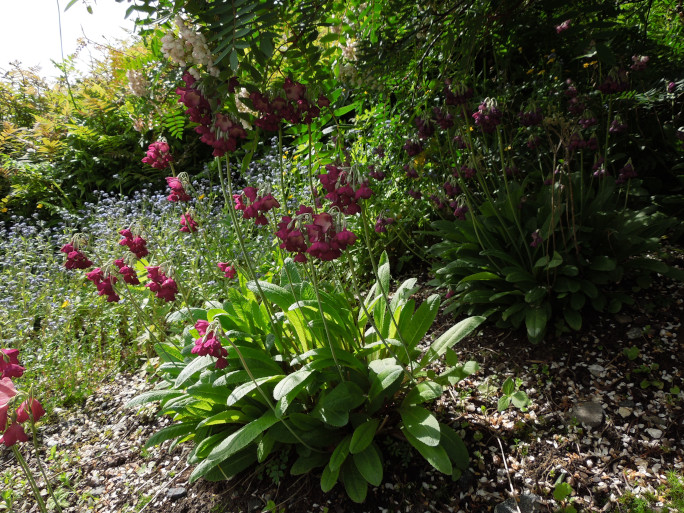
A short distance from the entrance of the garden was Primula secundiflora whose native habitat is the wet meadows of China, Sichuan and Yunman.

Primula waltonii, native to Tibet and Bhutan was collected by Frank Kingdom-Ward.

Main areas for collecting alpine primulas were the Himalayas, North Burma; in China – Szechuan,
Yunnan, Kansu & Hupeh. George Sherriff and Frank Ludlow traveled primarily in the Eastern Himalayas and introduced many new plant species including the primulas. Frank Kingdom -Ward (1885-1958) known in Burma as “flower chief,” was the last of the really great individual plant collectors providing the British gardeners with his primula finds from Tibet, Yunnan and the Himalayas. The Primula florindae, with yellow blossoms, is found near the marshes and streams of Southeast Tibet.

NORTH AMERICA
Western North America mountain flora from the Rocky Mountains, the Cascade Range and the Sierra Nevada mountain range along the eastern edge of California, have native plants which have adapted successfully to the northern climate of Tromsø. Important to the early expansion of the United States, was the expedition of about forty men under the name Corps of Discovery, commissioned by President Thomas Jefferson. Meriwether Lewis and William Clark were military men in charge of the expedition. They embarked on the President's behalf from St. Louis in 1804, to find a water route across North America and map and the region unknown at that time. President Thomas Jefferson instructed them to "notice the soil and face of the country, its growth and vegetable productions."
By the end of the journey at the Pacific Ocean in 1806, Lewis had collected and described numerous species of plants. There were dozens of plants previously unknown in the specimens collected and pressed; found from the northern Great Plains through the Columbia River Gorge on the Washington-Oregon border to the Pacific forests. Lewis carried with him Carl Linnaeus's illustrated guide of scientific classification of the plant kingdom, which helped him with his anatomical terms he used in his journal. For technical reference of plant anatomy and classification, he referred to Dr. Benjamin Smith Barton's "Elements of Botany. Lewis wrote extensively in his journal of his observation of plants, minerals, geography, animals and the Native American Indians he encountered on the cross country journey. Having knowledge of the plants of the eastern territory, (his mother was a herbalist and he was schooled in botany by Dr. Barton before the journey) he also made notes; comparisons of the plants of the same species found in the eastern range to those in the western mountainous range and the Pacific Coast. The shooting stars, phlox, penstemon and bitter-roots, are just a few of the plants recorded by Lewis that can be found thriving in the Tromsø garden.
At the Lewis & Clark Herbarium at the Academy of Natural Science in Philadelphia, there are pressed sheets of 227 botanical specimens from the expedition housed there and Kew Garden has eleven specimens. It was several years after Lewis's unfortunate death in 1809, that a new plant genus Lewisia, (family Portulacaceae) was named after him and his discovery of the species, by Frederick Pursh. Pursh also named a genus with now 36 species, Clarkia, for a pink petaled, deeply lobed leaved flower that Lewis collected common named ragged robin (Clarkia pulchella) in honor William Clark.

We were to early to see the July blooms of the bitter-root Lewisia rediviva ( as it was named by the German botanist, Frederick Pursh) native to the Rocky Mountains and now the State flower of Montana. Before blooming, it's succulent leaves wither down in the spring and then the flowers grow directly from the rhizomes. It was an important medicinal plant for the Native American's and also used as a food with the white core of the roots being boiled till no longer bitter. The root can also be dried to form a cornmeal. Lewis had been told by the Native American Indians how to prepare the fibrous roots for a food source but he found them so bitter, it made him ill on his first encounter. On the return trip on July 1st, 1806, while camped on the Western slopes of the Rocky Mountains at Travelers Rest (now Missoula, Montana) he found the large petaled pink flower once again. This time he picked the bitter root only to flatten and press it to add to his herbarium collection.
Lewisia rediviva ("come back to life") was found to be a tenacious plant; not willing to dry completely between the pressed pages. Two years after L. rediviva was pressed between pages, it was found sprouting. According to the Curtis Botanical Magazine, a specimen collected in British Columbia by Dr. David Lyall, while on the Boundary Expedition, was immersed in boiling water to stop growth and than dried out. A year and half later is showed symptoms of vitality and was planted. In May of 1863, it produced a beautiful flower in the garden at Kew. This revived plant in flower is shown in Curtis's Botanical Magazine, Comprising Plants of the Royal Garden of Kew- by Sir William Jackson Hooker, August 1st, 1863; volume 89 t.5395. The artist for this lithograph was Walter Hood Fitch.

Pushing up through the dry gravel of the mountain display on our June visit was the Lewisia cotyledon var. alba, with open funnel-shaped white blooms. It is the hardiest of the Lewisias and has gained the Royal Horticulture Society Award of Garden Merit. Tromsø grows about ten species of Lewisia in the North American collection.

Frank Tweedy was a United States Geological topographer working in the west who was also a botanical collector sending alpine species back to Philadelphia for study. His collections were primarily alpine as it is said that his collections were done secondary to his occupation while climbing mountain peaks or returning to camp. From 1881-1891, he did make botanical collections for the US Geological Survey of Montana, Idaho and Washington. While on Mt. Stewart in the Cascade Mountains near Winanatchee, Washington, in 1882, he discovered what is now considered the regions showiest alpine plant with colors ranging from light pink to apricot or coral. The alpine grows in rocky scree-like soil in the mountains rocky slopes and crevices with thick, fleshy roots that can grow two to three feet long. Asa Gray named this alpine mountain rose queen, which blooms May to July, Lewisiopsis tweedyi.
Years later in 1990, the name changed to Cistanthe tweedyi, when it was moved from the genus Lewisiopsis to the genus Cistanthe. and also moved from the Portulacaceae family to the Montiaceae family. Regardless of the displacements and name change, (disliked by alpine enthusiasts loyal to Meriwether Lewis and the botanist of Oregon and Washington), the Tweedy's bitter-root has been a remnant since before the Ice Age; older than the mountain range Frank Tweedy climbed. It can survive summer temperatures of 100 degrees F. (38C.) in the summertime and minus 30 degrees F. (-34C.) in the winter. It is endemic to western North America in north central Washington and adjacent British Columbia; typically found at elevations of 1,500 feet, where it hides from the sun in the shade to 4,500 feet (460m to 1,370m), where is basks in the sun. The seeds have a sweet honey scent which attracts ants that carry away the seeds to eat the outer skins of the seeds. The dropped bare seeds start new colonies at a distance from the parent plant, establishing a new colony.
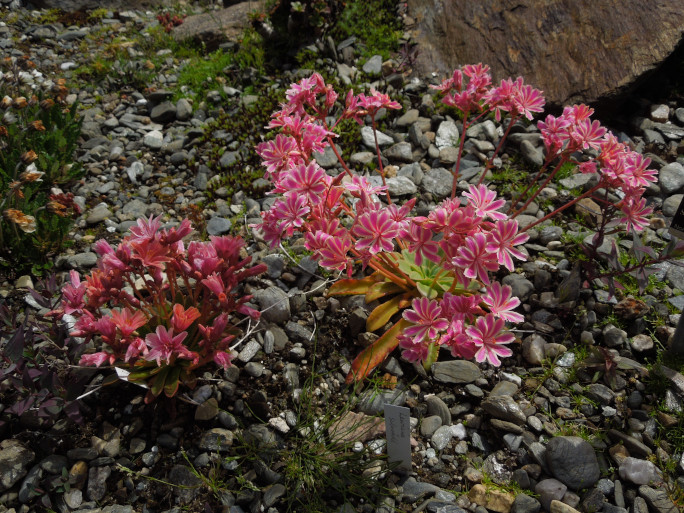
Frank Tweedy self published in 1886 "Flora of the Yellowstone National Park," which was the parks first botanical guide. The book covers a collection of 605 species within the Montana, Idaho and Wyoming lands in the Yellowstone National Park that Tweedy collected during August-September 1884 and June through September 1885. His collections were so thorough that a future collector in 1898, was advised to travel and work in the park where Tweedy had not been those two summers to avoid repetition. Tweedy's book first printed on paper in Philadelphia, is now available in electronic form on-line or as a reproduction in a book form. Tweedy's writing is considered an important part of the early knowledge of the flora of the Yellowstone area.
Kew Gardens received a specimen of the Tweedy's bitter-root from an Oregon nursery, which bloomed for them in 1898. It was awarded the Royal Horticulture Society's Award of Garden Merit in 1901. Tweedy's bitter-root does not set seed well in the garden. It is cultivated from cuttings or from the collection of native seeds. Presently it is on the State of Washington's watch list of species at risk due to over collection of seeds and specimens plus habitat loss. For the mountain climber, Tweedy's name continues in Montana's Pioneer Range where the highest point is named Tweedy Mountain. For the alpine enthusiasts, look for other plants in the northwestern mountains that are assigned the tweedyi name.
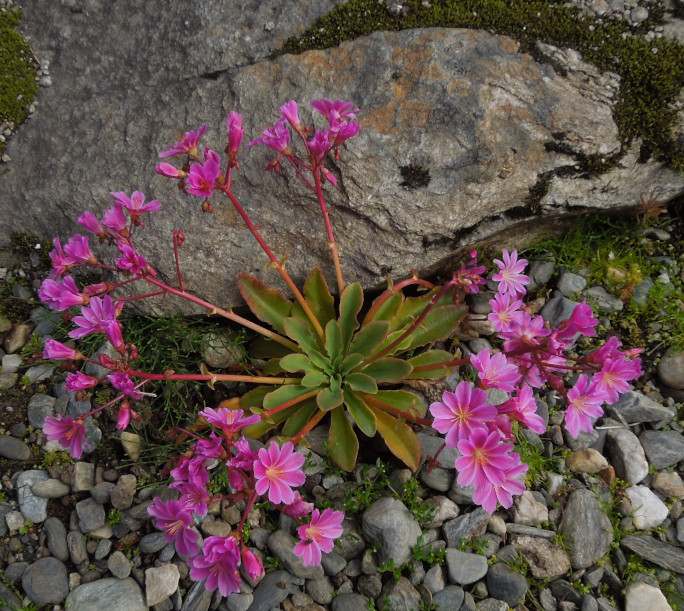
Alaska is represented in the North American terrain by the bellflower Campanula chamissonis, with May to June blooms of bell shaped, single tubular blue flowers, that face upright on short stiff stems. Campanula chamissonis (family Campanulaceae) also makes its home in northern Japan through eastern Siberia, along the Aleutians and into northwest Alaska. It is a popular plant for alpine growers who will place these plants in the crevices of their stone rock gardens were it will grow vigorously, spreading by rhizomes. It is easier for growers to increase their stock by digging and dividing the mass of underground stolons as the seeds of this bellflower need not only light to germinate, but also exposure to fluctuating temperatures, including freezing weather for about three months. Tromsø's weather has provided the ideal location for C. chamissonis, home away from home.

Native to the Western States in the cool climate of the Rocky Mountain, now making a singular stand on top of the granite outcrop at Tromsø,was a bristlecone pine, Pinus aristata 'Sherwood compact'. A slow growing pine it thrives in cool climates. At the base of the pine, the bronze leaves of the cold hardy (to -20 degrees F/-34 c.) Heuchera '’Emperor’s Cloak’ spilled over the gravel landscape along with tiny sedums. There was a splash of rose color against the granite from clumps of the flowers of Tweedy's lewisia.

Several varieties of cushion forming evergreen phlox, including Phlox douglasii 'Boothman' with a dark pink eye surrounded by pale pink petals, native to South Washington and California, grows in well drained, gritty alkaline soil, were a part of the Rocky Mountain landscape display at Tromsø. .
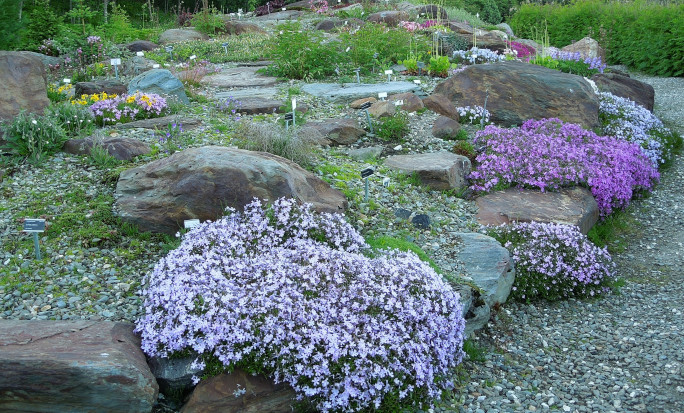
THE ARCTIC
At the Tromsø Botanic Garden they have a collection of plants which grow north of the polar treeline so are not often seen in residential or other botanic gardens. On the north facing rocky slope of the display are plants from the high Arctic Norwegian Svalbard archipelago. This archipelago is comprised of many small islands and a few larger ones; the largest one named Spitsbergen. The group of of islands are approximately 373 miles (600 kilometers) from the Norwegian mainland and 621 miles (1000 kilometers) to the North Pole. According to the "Flora of Svalbard", there are as many as 184 native species of vascular plants in the archipelago (plus 13 introduced plants) with discovery of new species still being made and new populations of rare species being found.
Svalbard has seen the greatest temperature increase of any place in Europe for the past three decades. Researchers are currently attempting to understand what that will do to plants the have evolved under thick winter blankets of snow, but with global warning are faced with more rain and ice. At Tromsø they have in their collection over 30 species of plants from Northern Norway and Svalbard, which are being preserved outside their natural habitat, that are endangered species. At Tromsø the conservation of the genetic material is important in case something should happen to the wild population, as 48 of the vascular plants listed in the archipelago are Red listed from vulnerable to critically endangered.
Native to most of the high Arctic, including Svalbard, north-easterly Finland, north-eastern Greenland (a rare population), as well as Alaska and Canada, is a 2"-4" (5-10 cm.) tall plant with blue bell shaped flower that finds its place on well drained, dry gravely slopes and in crevices, Polemonium boreale, also called Boreal Jacobs-ladder, of the Polemoniaceae family. The plant reproduces, not by vegetative reproduction, but by its heavy seeds that do not have any adaptation to dispersal. It’s flowers, which have a slightly unpleasant smell, are insect pollinated. On south facing slopes it grows in heaths and meadows, often in places close to bird colonies where there is manure. At Tromsø Botanic Garden, the plants that grow in the rocky landscape there, are from Svalbard and north-eastern Finland, it's only Scandinavian location.
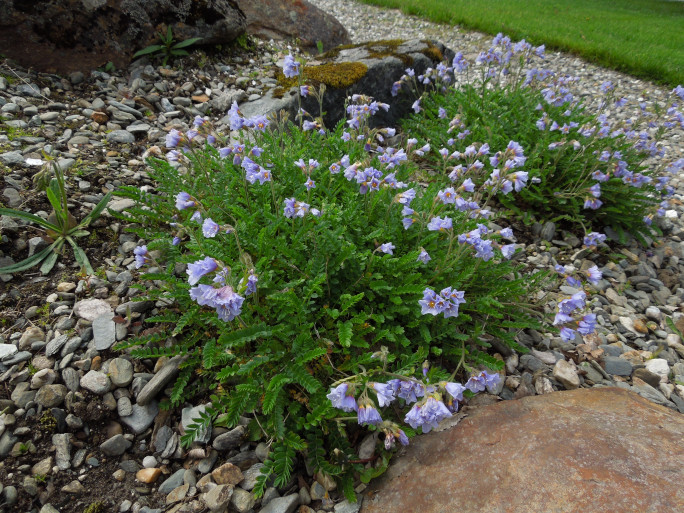
The importance of "rescue cultivation," is displayed at Tromsø with a buttercup of the large Ranunculaceae family. Out of this expansive family of about 400 species, in Svalbard there are only four native Ranunculus (R. arcticus; R. nivalis; R. sulphureus; R.wilanderi) plus three that were introduced. Within this small grouping of buttercup species, Ranunculus wilanderi,(Nath.) Á. Löve & D. Löve, as of last count numbered 51 plants at its only worldwide location, in the damp moss tundra at Kapp Thordsen (Dickson Land), on the north side of Isfjorden in the central part of Spitsbergen Svalbard. The species became known there in 1871 by Swedish botanist Alfréd G. Nathorst, when he was sent to Svalbard with Hjalmar Wilander, an engineer, to investigate valuable mineral deposits and to study the fossil flora of the Arctic region.
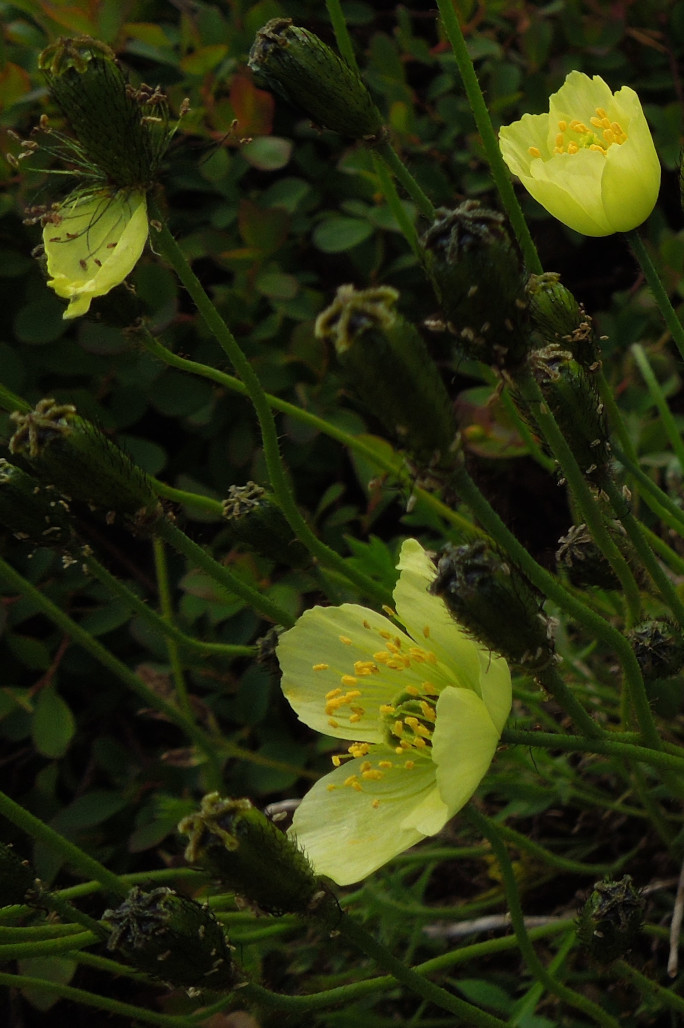
Nathorst was the authority in the description and scientific classification of the Arctic yellow buttercup that he had observed and collected but did not name until 1883, as Ranunculus affnis f. wilanderi. whose origin and evolution is still unknown. No other areas of R. wilanderi have been found since than.
In his lifetime, Nathorst became known as a Swedish Arctic explorer, geologist and palaeobotanist. His name is attached to several geographical formations in the Arctic as well as about 50 plants, living fossils, and animals that have his name built in their own.
The specimens at Tromsø are representative for most of the genetic variations within the Kapp Thordsen population, so if the R. wilanderi should become "extinct in the wild due to anthropogenic (man made) disturbances, it could still be reestablished artificially." It is currently threatened by changes in the Arctic climate. The damp moss tundra where R. wilanderi is found, is rare within Svalbard and sensitive to changes in precipitation and temperature. The arctic wetlands are expected to get drier as the temperature gets warmer. With the warmer climate, taller species from the southern range that are faster growers, will move further north and overtake the slow growing Arctic species.
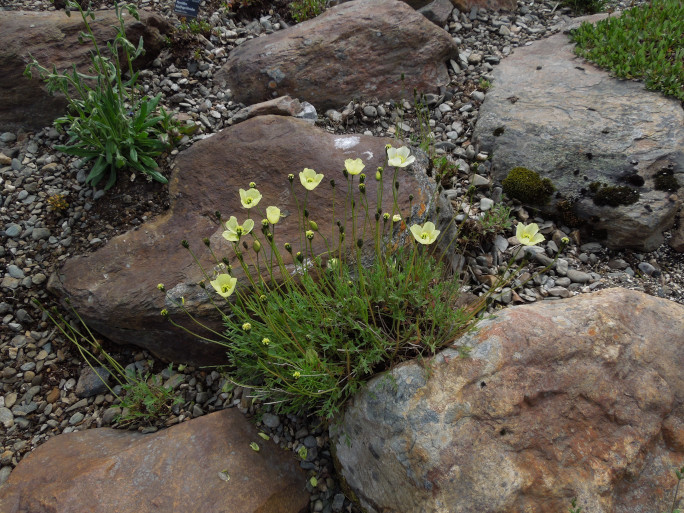
Rhododendron Collection
Fossil records show that by 60 million years ago, (before the creation of the Himalaya Mountains) Rhododendron had evolved and spread to all of central Europe, China and eastern North America.
Now Rhododendrons are mainly centered in Asia, especially in China and the Himalayan Mountains with some species found into the Arctic, North America and Europe.
The key to grow successfully rhododendron in far northern Norway, according to Arve Elvebakk, is to select species and their hybrids and cultivars that originated from higher altitudes than those found in southern Scandinavia. Using less acidic and organic soil than normally used for rhododendron, agrees with the ecological conditions met along the altitudinal gradient in Asia. These species and cultivars are not as tall as rhododendrons found in the gardens of the south. The dwarf and compact growth habit and very small leaves, are an adaptation to their rigorous northern environment.
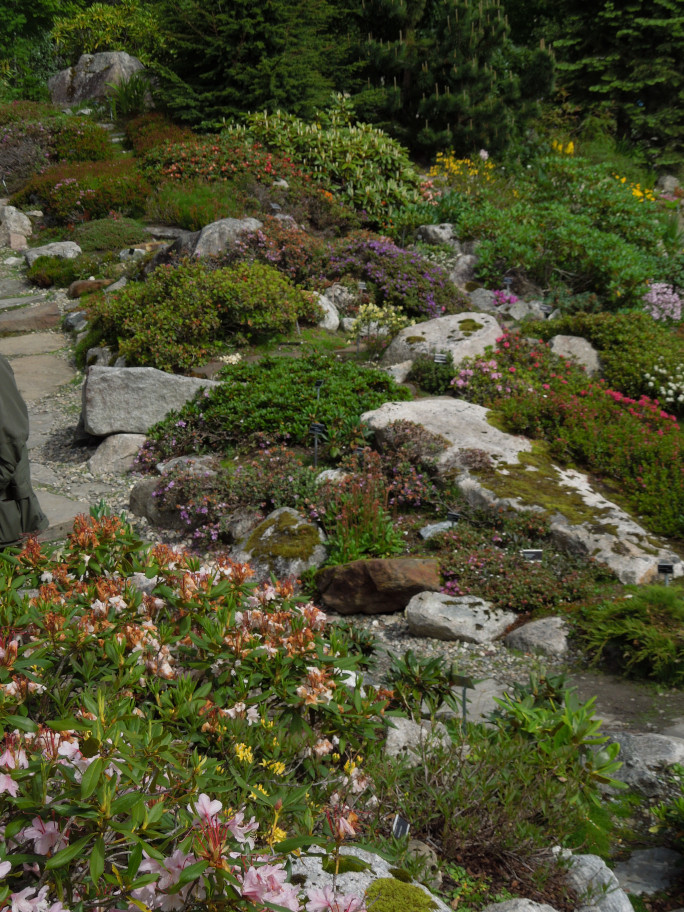
Rhododendron flinckii Davidson sp. Nov. was first found by Roland E. Cooper (one of Bulley's collectors from Bees Ltd.) in June 1915 in Kopub, Pumthang, Bhutan. The species grows in the upland sheltered areas in the evergreen forests of fir trees and scrub at an elevation of 10,000 feet. It was introduced into cultivation by Explorers Frank Ludlow and George Sherriff in 1936. It was reintroduced from Bhutan in 1990. H.H. Davidian named this rare rhododendron after Mr. K.E. Flinck, "in recognition of his outstanding contributions to the cultivation of rhododendron in Sweden."
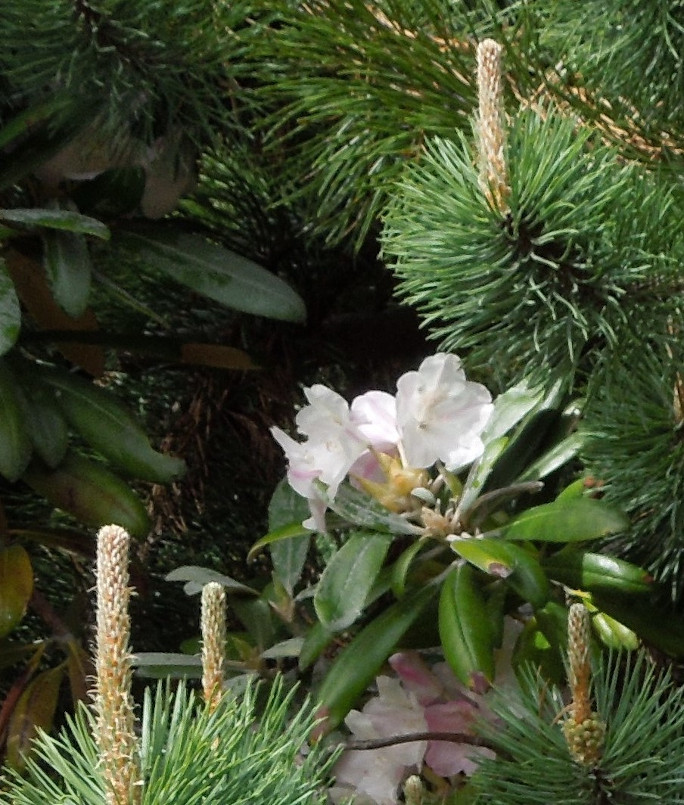
Rhododendron wardii, a yellow flowered rhododendron with wine red blotch, was collected by George Forrest in July 1917, in Western N.W. Yunnan-Mekong-Salween divide, China. The Royal Botanical Gardens, Kew holds this herbarium specimen. Ludlow, Sherriff and Hicks also collected the R. wardii in Southeast Tibet in 1938. The specific epithet refers to Francis Kingdom Ward (the English explorer known as the "flower chief in Burma), who collected the type specimen of the R. wardii. As a broadleaf evergreen shrub, it can grow in the wild up to 15-20 feet tall (4.5 -6 m.) and at altitudes of 3000-4600 meters, in it's native habitats of China, NW and West Yunnan, SW Sichuan and Southeastern Tibet. As a garden shrub this species is contained at 4 feet (1.2m) tall.
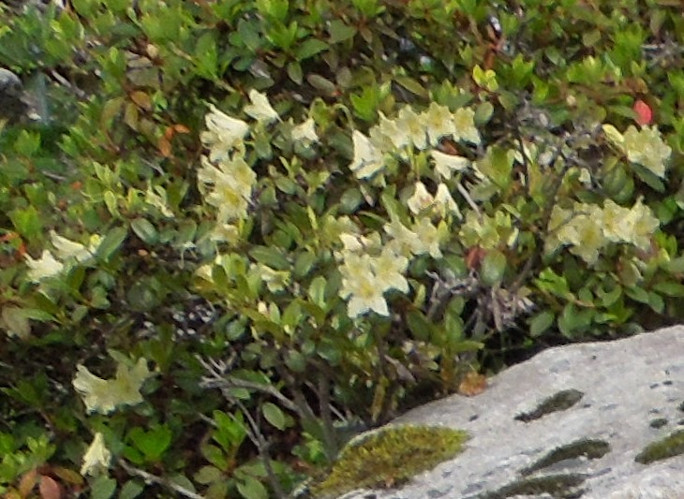
Europe has few native rhododendron. Found in the alps in a narrow altitudinal belt of acidic soil is Rhododendron ferrugineum, a compact evergreen shrub known as Alpine rose. It does not do well as as garden plant.
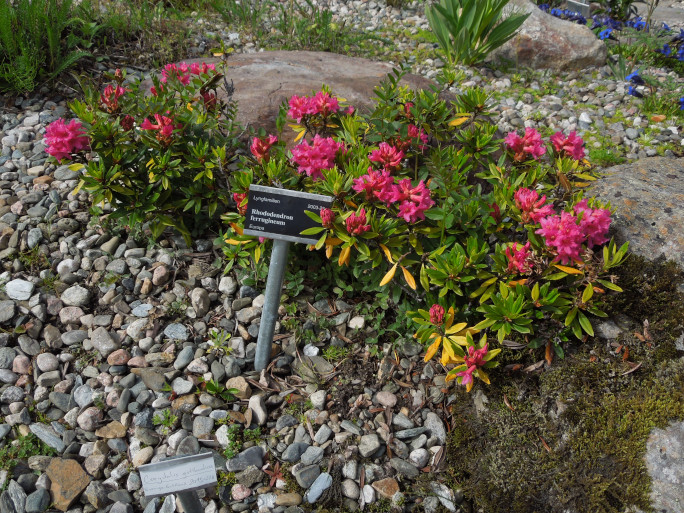
SIBERIA AND KIROVSK FRIENDSHIP GARDEN
Before Tromsø was established, the town Kiroksk, on the Russian Kola Peninsula, had the world's most northerly garden. Kiroksk has provided Tromsø Botanic Garden with a number of plants which have been collected at the top of the Tromsø garden in what is named the Friendship Garden.
Lilium dauricum var alpinum or Siberian Lily is native to the cold climate of Siberia, the Russian Far East, Mongolia, NE China and Japan. Dauricum is named for a region in Siberia. The L. alpinum variety displayed in the Friendship garden is unique as it is the shortest of the Lilium species reaching only 6” (13cm) in height but having a normal sized orange flower.
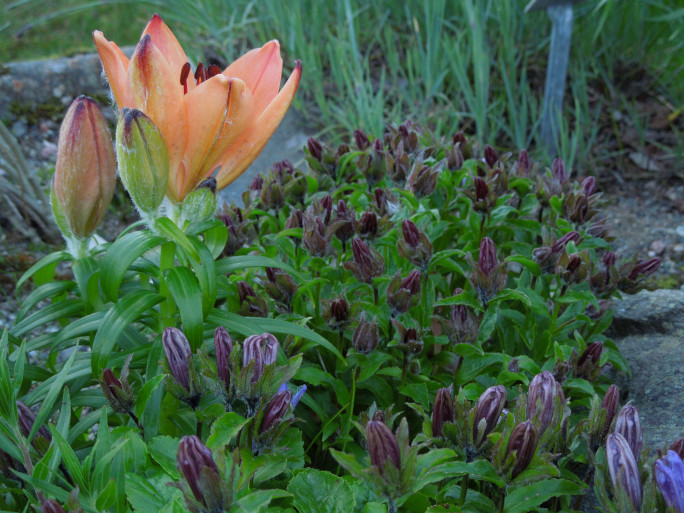
The Aquilegia glandulosa, commonly known as Siberian columbine is native from central and East Asia to Siberia in the Altai Mountain Range. It tolerates temperatures down to -40 degrees F. (-40 C.)
It is a popular plant for the alpine gardener with a height of 6-12".
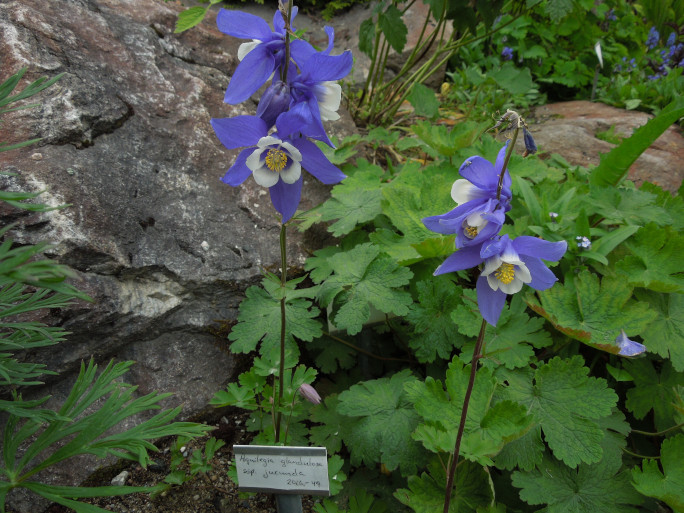
THE HIMALAYAN COLLECTION
The highest point of the garden is the Himalayan collection which includes plants from Himalaya and the neighboring mountains, including those of the western provinces Sichuan and Yunnan in China. The high altitude plants (11,483-18,045 ft./ 3500-5500 m) from those southern mountain chains do well at Tromsø with similar climate conditions; heavy rainfall in the cool summer and abundant snowfall in long winters. The predominant plants in this collection are the Tibetan blue poppy–Meconopsis (sharing ground with the nearby Paeonia Garden), Cremanthodium daisies and shrub forming rowans. The rhododendrons, primulas, saxifrages and gentians of the Himalaya are planted in their own collections in other areas of the garden.
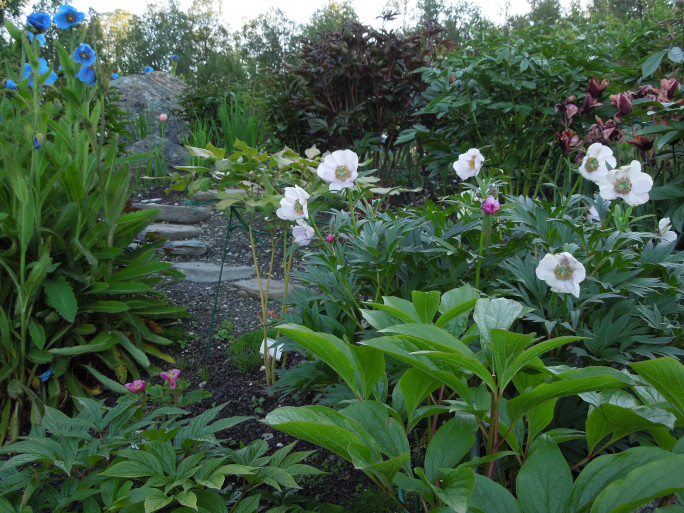
Cremanthodium ellisii of the Asteraceae family, is commonly known as the Himalayan mini sunflower. Thick underground creeping rhizomes store nutrients enabling the plant to grow on lower parts of slopes where there are heavy snow deposits providing moisture. Growing at an altitude of over 10,826 feet to 15,748 feet, (3,300 to 4,800 m), where the snow cover last long, the season is short with a flowering period of July to September in its natural habitats of Nepal, China and Tibet. The C. ellisii is listed as a medicinal plant. The collected plant material consists of the flowering aerial parts. Joseph Dalton Hooker who was the first European to collect plants in Himalaya (and India), is associated with this plant.
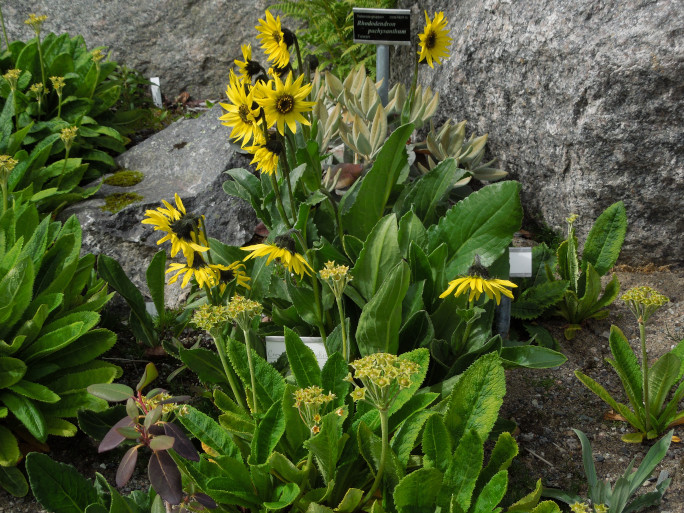
Tromsø provides ideal conditions to grow Meconopsis species (a genus within the poppy family Papaveraceae) which are known for their large flowers, not only in blue (as the Himalayan blue poppy) but also the colors of violet, red, yellow or white. M. baileyi (formerly named M. betonicifolia after Père Jean Marie Delavay sent pressed specimens in 1886 to Museum of Natural History in Paris), and M. Lingholm, are two of the most commonly grown blue poppies. Most of the 78 species in the genus are monocarpic (they die after flowering), so these favorites have their seeds harvested to continue the population in the garden. Outside of their native habitats they thrive best in acid soil (high pH the blooms will turn pinkish-purple) in cool, moist woodland found in Scotland, Ireland, coastal British Columbia, Alaska and the north of Norway. In the lower 48 of the United States, coastal Washington and Oregon mimic the closest climate to have success of growing the poppy in a residential garden. Preferred temperatures are in the 50-60 degree range since extended temperatures of 70 degrees will cause the plant to begin to burn out.
Meconopsis grandis is the national flower of Bhutan known commonly as the Tibetan poppy. M grandis, as its name implies, is a large pure blue poppy with flowers 4-5” across. It is native to the western Himalayas, northern Burma, Tibet, eastern Bhutan, the Arunachal Pradesh (India) Bhutan frontier (rediscovered 2004 by Peter Cox) and Yunnan Province in China. It populates the shady mountain areas, mountain meadows, slopes and woodlands where it is cool and moist. M. grandis was first discovered in Sikkim in the 1880’s and first flowered in cultivation in 1895. George Sherriff’s collection of seed from eastern Bhutan in 1934 first flowered in cultivation in 1937 at Branklyn Garden in Perth and at the Royal Botanic Garden Edinburgh. The descendants of these plants are named collectively as M. George Sherriff Group.
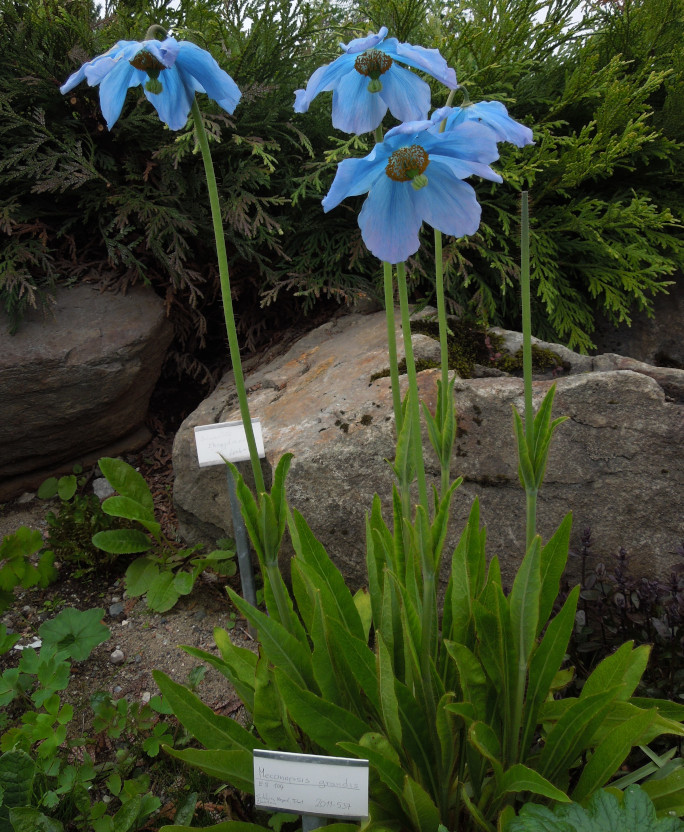
Even though the Meconopsis poppies are the highest growing flowering plants found, they are under threat in their native alpine regions. According to an article in ScienceWise Magazine, (March/April 2008) a study done by a PhD student at that time Hongyan Xie, on the flora and fauna of her native Tibet, found that the poppy is being impacted by climate change with the increasing temperatures allowing competitor species to move upwards and colonize the Meconopsis habitat. In the short term, the poppy is not able to move to a higher altitude and adapt since environmental factors are not the same.
The author also noted that in Tibetan medicine the Meconopsis in combination with other local herbs, is used to treat inflammation and assist in healing fractures. Tibetan medicine has become popular in China which has increased the market value of the plants. Now the locals gather the poppies to sell while out tending their yaks. The Meconopsis plant has not been commercially viable to cultivate so the medicinal plants come from those collected in the wild. An increase in human population has also lead to more picking and demand for the poppy as medicine. The population increase has also led to more yaks that in turn have displaced the smaller grazing animals in areas where the poppies grow. Even though the yaks do not eat the poppies, there is heavier grazing in those areas now which may contribute to the decline in their numbers.
It was observed in the study that in this area of diversity where bumble bees suited to the higher altitude, would move from flower to flower on the warmer summer days carrying pollen on their bodies. In the cool afternoon the Hoverflies were also pollinators; settling down into the poppy flowers for the night and in the warmer morning air would fly out.
From her study of the Meconopsis, Hongyan sees this attractive plant as an "indicator species" and what happens to this plant will affect what happens to other species that "may be less visible and less attractive, but are just as vital to the complex web that forms the ecosystem." An early warning call that is still relavant today.
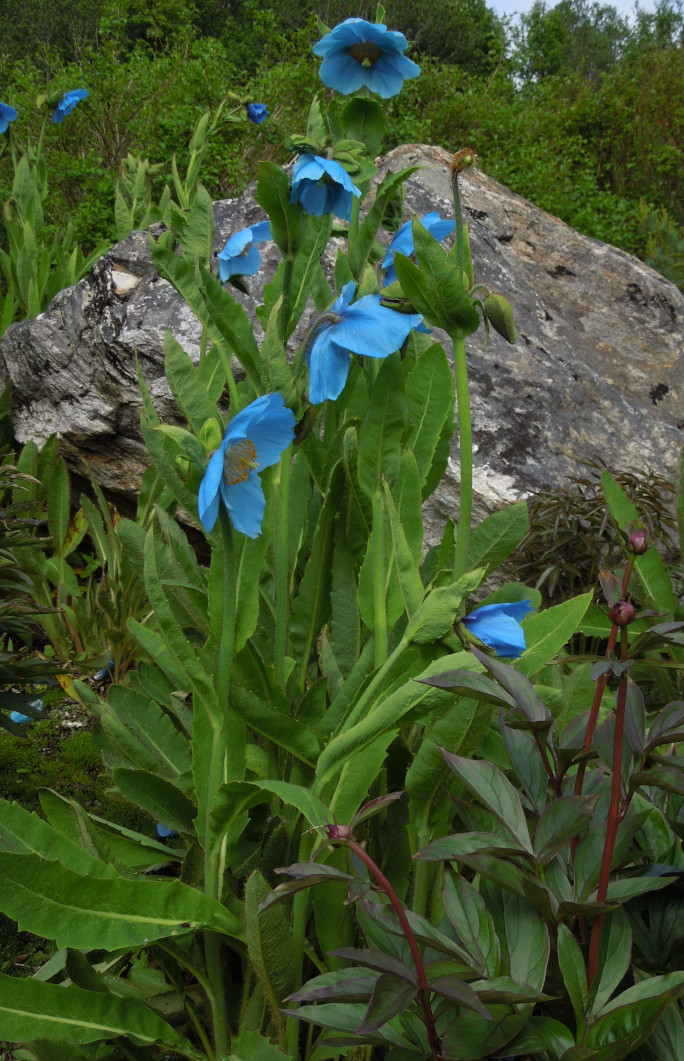
We returned to the garden in the evening hours that day while waiting for the Hurtigruten Cruise ship that would take us on a three day trip from Tromsø to Trondheim along the Norwegian fjords. At eight o’clock on a Sunday evening, the garden had few visitors. The weather was still pleasant; the difference is the Arctic evening light. A softer light – but the true blue of the Meconopsis and gentiana were vibrant; the lavender phlox soft; the white petals of the daisies and peonies popped to the forefront. The North American bristlecone pine tree, appearing as a silhouette on a pedestal, was stark against a cloudless sky; where light had faded pale blue. If you have a chance to visit a garden in the early evening hours shortly before dusk, do so. A meditative space.
Credits
Photos by Deborah Ellen McMillin
Bibliography
Alpine Garden Society – Calceolaria lanceolata http://encyclopaedia.alpinegardensociety.net/plants/Calceolaria/lanceolata
Botany Boy. "Cypripedium-tibeticum-a highly variable chinese lady slipper orchid." Retrieved from http://botanyboy.org/cypripedium-tibeticum-a-highly-variable-chinese-lady-slipper-orchid/
Elwes, Henry John. 1880. A Monograph of the Genus Lilium https://www.biodiversitylibrary.org/item/10264#page/103/mode/1up
Hanelt, Peter. editor Mansfield Encylopedia of Argriculture and Horticulture Crops SpringerA-Verlag-Berlin Heidelberg, New York
Kuss, Patrick, Hafdi’s Hanna Ægisdóttr, Jürg Stöcklin (June 2007) The biological flora of Central Europe: Campanula thyrsoides L. Institute of Botany, University of Basel, Switzerland. Retrieved from https://www.sciencedirect.com/science/article/abs/pii/S143383190700025X
McCourt,Richard, Spamer, Earle. 2004. Jefferson's Botanist Lewis and Clark Discover Plants of the West. Philadelphia The Acadamy of Natural Science.
Medicinal Plants of the Russian Pharmacopoeia; their history and applications – Review
Alexander N.Shikova – Olga N.Pozharitskayaa – Valery G.MakarovaHildebert – WagnerbRobVerpoortec -MichaelHeinrichd -Abstract. Journal of Ethnopharmacology – Volume 154, Issue 3, 3 July 2014, Pages 481-536
Metcalf, Lawrie, Alpine Plants of New Zealand : Reed Publishing Ltd.
Milne, Richard. 2017. Rhododendron. London: Reaktion Books LTD
Naturalist https://www.inaturalist.org/taxa/356272-Linum-flavum
Oliver, W.R.B. "From Botanical Discovery in New Zealand: The Visiting Botanist,"School Publications 1952\
New Zealand – Ranunculus insignis http://nzetc.victoria.ac.nz/tm/scholarly/OliVisi-fig-OliVisi030a.html
Paghat's Garden: Lewisia tweedyi -The Garden of Paghat the Ratgirl. www.paghat.com/lewisia7.html
Patent, Dorothy Hinshaw. 2003. Plants on the Trail with Lewis and Clark. New York Houghton Mifflin Company
Plants Delights Nursery. Cypripedium 'Ulla Silkens'. Retrieved from
https://www.plantdelights.com/products/cypripedium-ulla-silkens
Plants Delights Nursery. Blog article. Retrieved from https://www.plantdelights.com/blogs/articles/cypripedium-orchids-lady-slipper-fit
PlantZAfrica. Cotyledon orbiculata. http://pza.sanbi.org/cotyledon-orbiculata – South African National Biodiversity Institute
Stafleu, F.A. "Marschall von Bieberstein and his Flora Taurico Caucasia" 1973
The Flora of Svalbard. (n.d.). Retrieved from Polemonium boreale Adams http://svalbardflora.no/index.php?id=713
The Flora of Svalbard. (n.d.) Retrieved from Ranunculus wilanderi (Nath.) Á. & D. Löve http://svalbardflora.no/index.php?id=593 Ranunculus wilanderi (Nath.) Á. & D. Löve
The Norwegian University of Science and Technology (NTNU)."Freezing plants to predict the fate of the Arctic." ScienceDaily. 31 March 2016. <www.sciencedaily.com/releases/2016/03/160331082645.htm>.
Rhododendrom flinckii https://scholar.lib.vt.edu/ejournals/JARS/v29n3/v29n3-davidian.htm & Frank Kingdom Ward
https://scholar.lib.vt.edu/ejournals/JARS/v29n3/v29n3-moodie.htm
https://landscapeplants.oregonstate.edu/plants/rhododendron-wardii